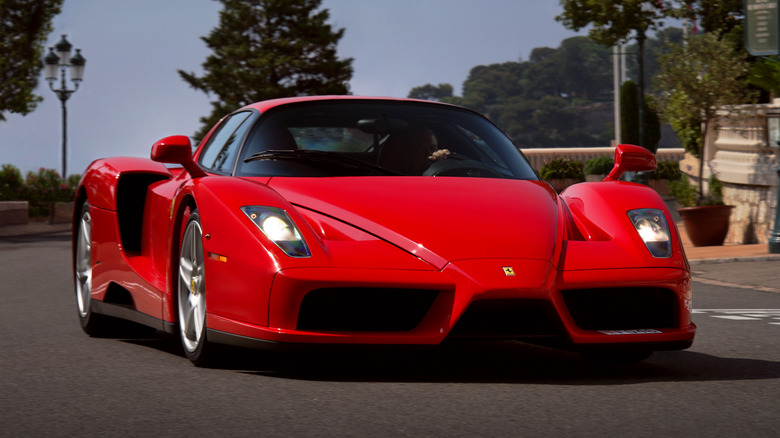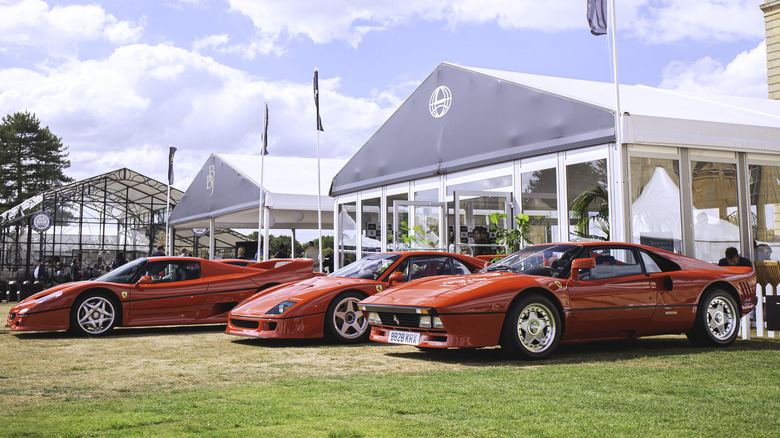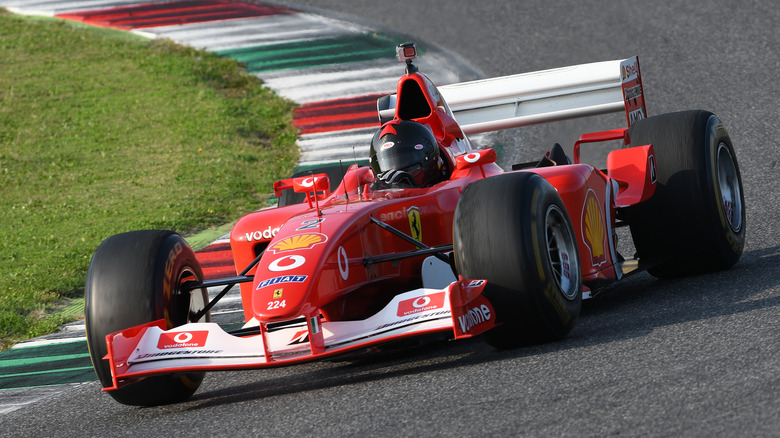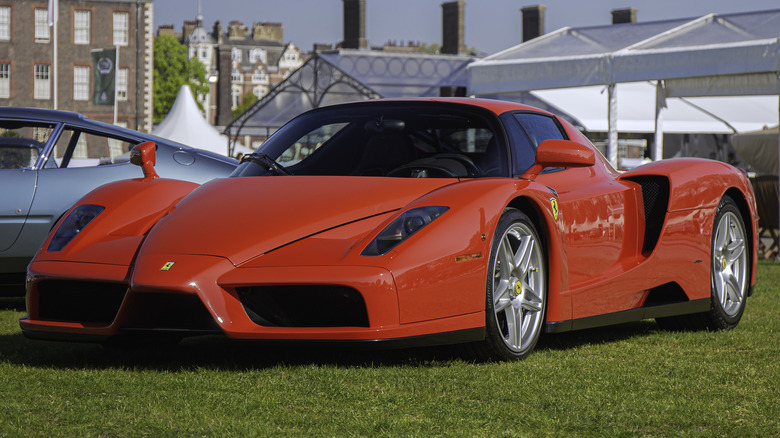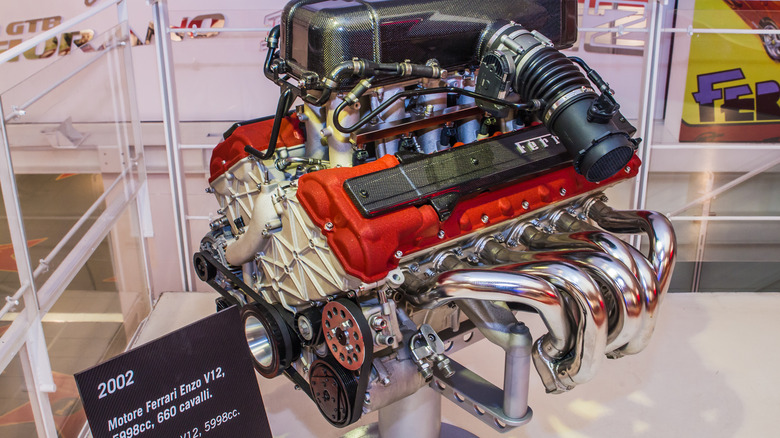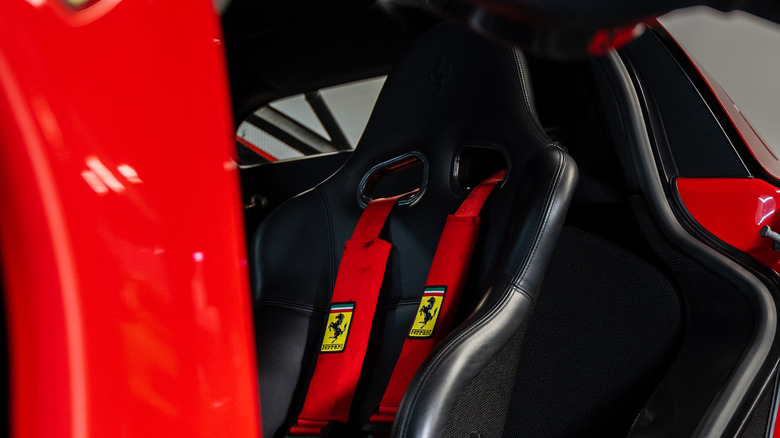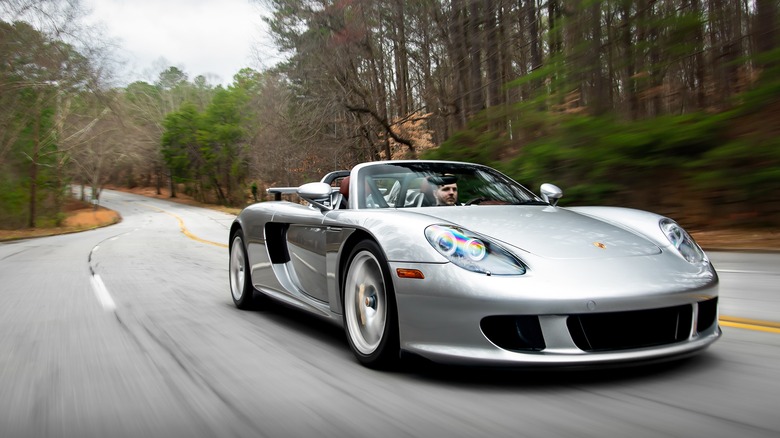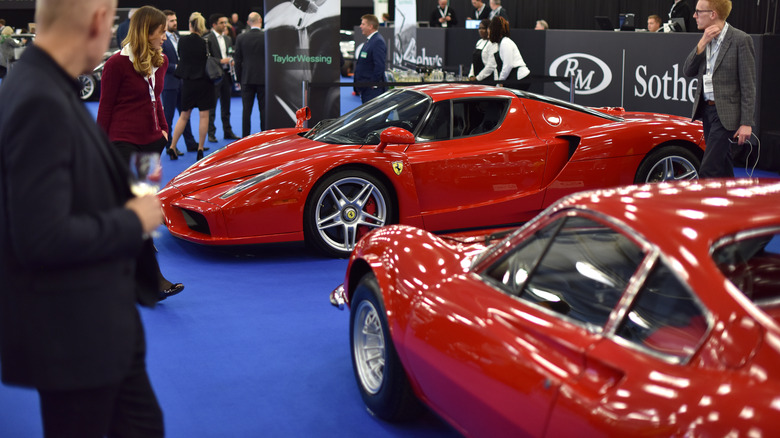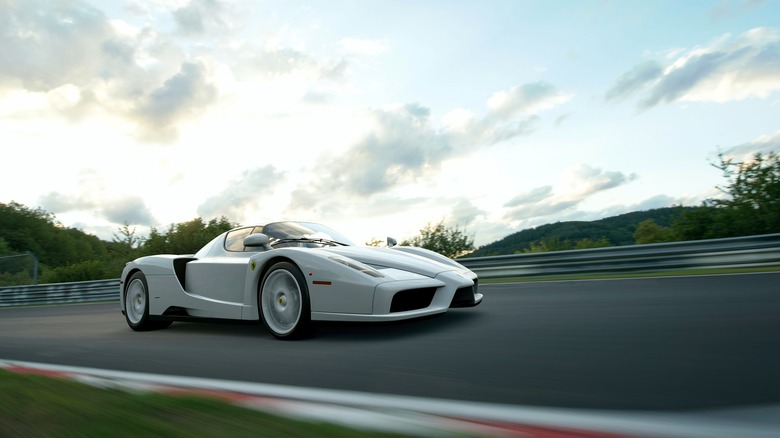Enzo: The History Behind One Of Ferrari's Greatest Cars
For any automaker, naming a car after its founder is a big risk. For Ferrari, a brand whose heritage is arguably tied closer to that of its enigmatic founder than any other, the stakes were upped even further. The car needed to be genuinely groundbreaking, pushing the envelope in both performance and design, establishing a new benchmark by which all of its other cars could then be measured. The Ferrari Enzo, unveiled in the summer of 2002, took the brand's Formula 1 technology and shoehorned it into a road car, creating one of the fastest Ferraris ever in the process.
It was just as revolutionary as a car bearing Enzo's name needed to be, taking Ferrari's halo supercar line to new heights and reasserting the Prancing Horse badge as one of the premier marks of cutting-edge automotive performance. In the two decades since the first example rolled off the production line, the Enzo has proven to be one of the most sought-after modern Ferraris among collectors, with average values rising far above its original asking price. To find out exactly why it's such a grail for many of the world's most discerning enthusiasts, it's worth looking back at its development history, and the key figures involved in its creation.
Catching up to the pack
Ferrari's line of limited-run halo cars began with the 288 GTO, which was originally developed as a homologation special to allow the automaker to enter Group B racing. After the cancellation of the Group B class, Ferrari had no need to build such a car, but preorders came in so fast that the company decided to go ahead and produce the road-going version anyway. A few years later, the next entry in the halo line would emerge: the F40, celebrating the brand's 40th anniversary and famously becoming the last car Enzo Ferrari would personally oversee before his death.
Then came the F50, which, despite selling out its 349-unit run, was seen as a bit of a misstep in the eyes of many. It took its racing influences from Formula 1 rather than rallying as the F40 and GTO did, and it was a bare-bones, difficult car to drive. It also debuted around the same time as the McLaren F1, which is still considered by many to be the best road car ever made. In recent years, the F50 has seen a revival in its fortunes, and prices have increased accordingly, but at the time of the Enzo's development, it was still seen as a slight disappointment. Not only did Ferrari have to create a car worthy of bearing its founder's name, but it also had to prove it was at the bleeding edge of road car development alongside McLaren and Porsche.
Formula 1 technology
Thanks to the talents of a certain Michael Schumacher, Ferrari was unbeatable in Formula 1 during the early '00s. Schumacher clinched five successive titles for the Prancing Horse between 2000 and 2005, and played a big role in the development of the Enzo. He was chiefly responsible for the car's handling, ensuring that its road manners were significantly better than the F50's, while still incorporating as much racing technology as possible.
That laundry list of technology included carbon-ceramic brakes, which were the first of their kind to be fitted to a road car, and a chassis made from carbon fiber and aluminum honeycomb. The suspension was also derived from Ferrari's Formula 1 car, with double wishbones at both the front and the rear, and active damping ensuring the car stayed stable at high speed. The six-speed transmission also was borrowed from the racing program, and was groundbreakingly quick for the era, taking just 150 milliseconds to shift gears.
Function over form
It wasn't just the mechanical elements of the car that took heavy inspiration from Formula 1 either — the design, penned by Japanese designer Ken Okuyama at Pininfarina, was also racing-derived. Okuyama himself made history by becoming the first non-Italian to ever design a Ferrari, earning him cult status in his native prefecture of Yamagata. The car's Formula 1 influence can most clearly be seen from the front, with the nose section designed to channel air around the car as efficiently as possible, at the expense of looking very different from Ferrari's other road cars at the time.
A similar design was featured on the Zagato-designed Ferrari FZ93 concept of the early '90s, but Okuyama's Enzo incorporates the same influences into a much more sleek and well-proportioned form. The Enzo was still considered to be one of Ferrari's less attractive designs at the time of its release, but the two decades since then have been kind to it, and most collectors now consider it to be one of the better-aged designs of its era. Aside from its racing-derived face, the other most notable design feature of the Enzo is its lack of a rear wing. Most other supercars of the time required a rear wing to send power to the ground efficiently, but the Enzo's innovative underbody produced enough downforce that a separate wing wasn't needed.
The F140 V12
A supercar is nothing without its engine, and the F140 V12 engine that made its debut in the Enzo is considered to be one of Ferrari's best to date. It produced 651 horsepower and became the most powerful naturally aspirated engine ever put in a road car at the time, although over the years, later iterations of the engine have boasted even higher outputs. The F140 is still in production, with the Purosangue SUV featuring an improved version of the engine.
Much like the rest of the car, the V12 was designed to be as lightweight as possible, although it's one of the few innovations that isn't derived from Formula 1. It's instead most closely related to the F136 V8, another of the brand's greatest engines that's since featured in everything from the Ferrari California to the Alfa Romeo 8C Competizione. As well as being unrelentingly powerful, the Enzo's engine also delivered a soundtrack worthy of a world-beating supercar. With the rise of electrification, that's something that may be lost on future Ferrari halo cars.
A bare-bones interior
Although it was built to be more comfortable to drive than its predecessor, the F50, Ferrari made only minimal concessions to creature comforts when it came to the Enzo's interior. As much bare carbon fiber as possible was used to keep weight down, with leather upholstery only where it was absolutely needed. The seats, much like the rest of the car, were racing-inspired, designed to keep the driver firmly in place even through the most high-speed corners. There was no stereo system, or electric windows, with the only non-essential item available being an optional air conditioning system.
Even the steering wheel took inspiration from Formula 1, with buttons for different drive modes lined up alongside either side of the central airbag. The indicators, oddly enough, were also operated through buttons on the wheel, while a switch for the horn was integrated into the wheel rim. It might have taken some getting used to, but reports at the time indicated that the Enzo's cabin was a pleasant enough place to spend time, a feat made more impressive considering Ferrari's forensic level of focus on performance and weight saving.
Tough competition
The Enzo might have been the fastest road going Ferrari ever made at the time of its release, but it wasn't the only supercar to be pushing the boundaries of performance. Both Porsche and McLaren, two of the brands responsible for diminishing the impact of the F50, were also in the midst of developing supercar rivals at the time the Enzo was unveiled. The Porsche Carrera GT was perhaps the most direct Enzo rival, since it also featured a bevy of racing technologies and used cutting-edge materials to reduce its curb weight.
The Mercedes-Benz SLR McLaren, while also taking inspiration from the racing pedigree of its two collaborators, was more of a grand tourer. That meant it wasn't quite as sharp around a track, but its straight-line acceleration was exceptional, and its top speed clocked in over the 200 mph mark.
There were other competitors, too: the Ford GT, unveiled in 2005, was a later entry to the market, but it boasted performance figures to rival its Italian and German competition. Although still a startup at the time of the Enzo's release, it would be remiss not to mention Pagani and its Zonda supercar, which took AMG's V12 powerplant and put it into one of the most outrageous cars to ever emerge from Italy.
A collectors' favorite
Even among such revered competition, the Enzo continues to remain one of the most, if not the most, desirable car of its vintage. Exactly what makes it such a collectors' grail is hard to pin down: Hagerty claimed its name was most likely the biggest reason for its appeal, since other Ferrari halo cars have been just as groundbreaking but never saw such sustained demand from buyers. There's also its status as an industry benchmark to consider — the Enzo not only represented a big technological leap for the brand at the time but also brought Ferrari back to the forefront of road car innovation after it had been lagging behind.
Ferrari's greatest cars have always been about celebrating the brand's heritage while delivering a cutting-edge driving experience, and few Prancing Horses embody those two things more completely than the Enzo. Data from Classic shows a slow but steady upward trend in Enzo resale prices, as more collectors come to the realization that there may well never be another Ferrari quite like it.
The last of its kind
The Enzo is an unrepeatable feat of engineering in the most literal sense, thanks to the rapid advancement of in-car electronics and electrified powertrains. The Enzo's successor, the LaFerrari, was one of the first hypercars to feature a hybrid system, a setup that's now become the industry standard. Likewise, the LaFerrari and most modern hypercars feature complex digital monitoring systems, which ostensibly improve performance but also take some of the ultimate control away from the driver.
While it features electronic systems that were cutting-edge for the time, it's generally considered to be among the last of the analog halo cars, as well as one of the last great naturally aspirated cars. Its status as one of the best Ferraris ever made is undoubted, but with the recent news that Ferrari plans to make 40% of its sales entirely electric by 2030, the next Ferrari halo car will likely be just as groundbreaking. However, it almost certainly won't follow Enzo Ferrari's original formula as closely as the car that bears his name.
